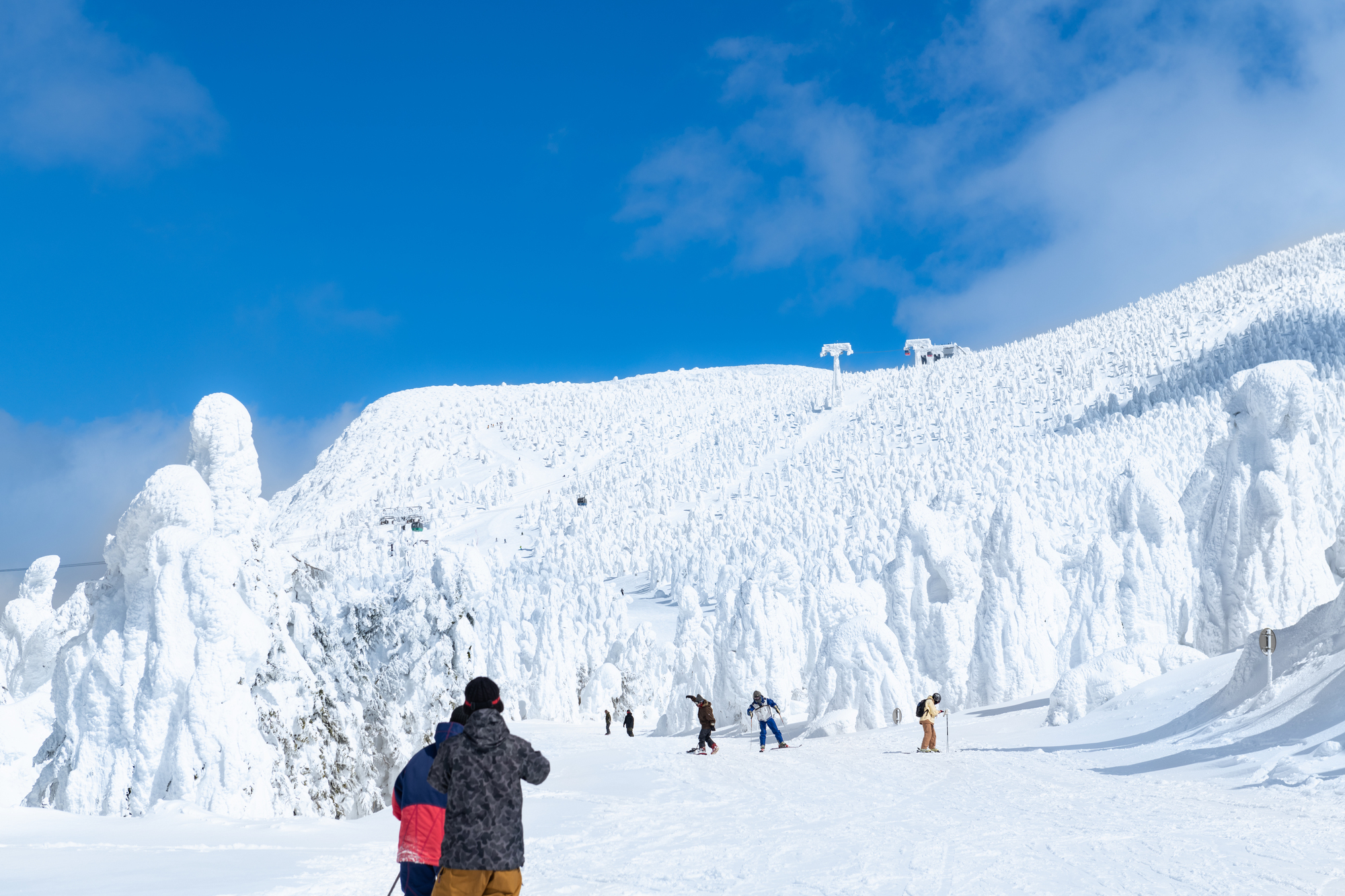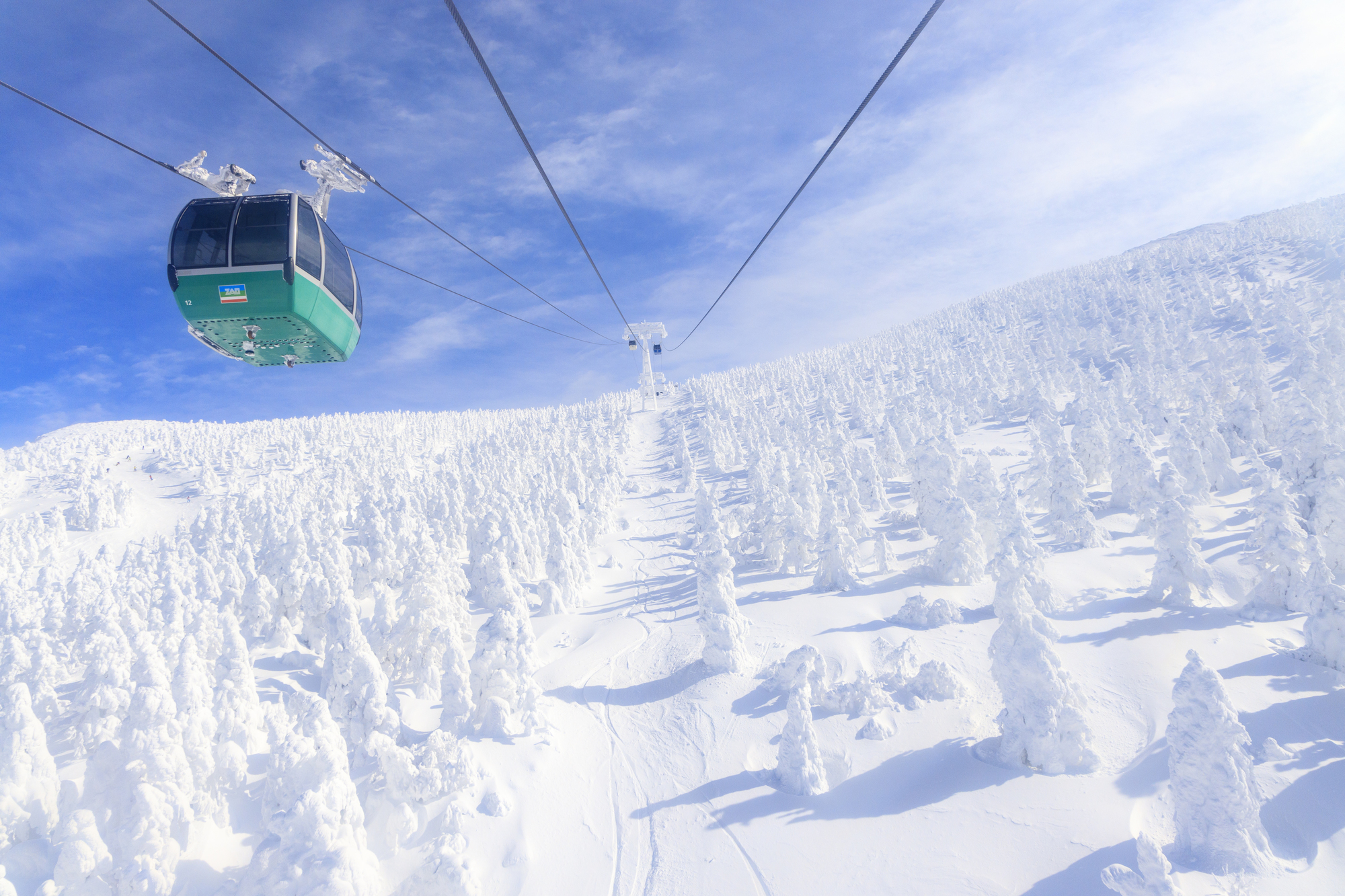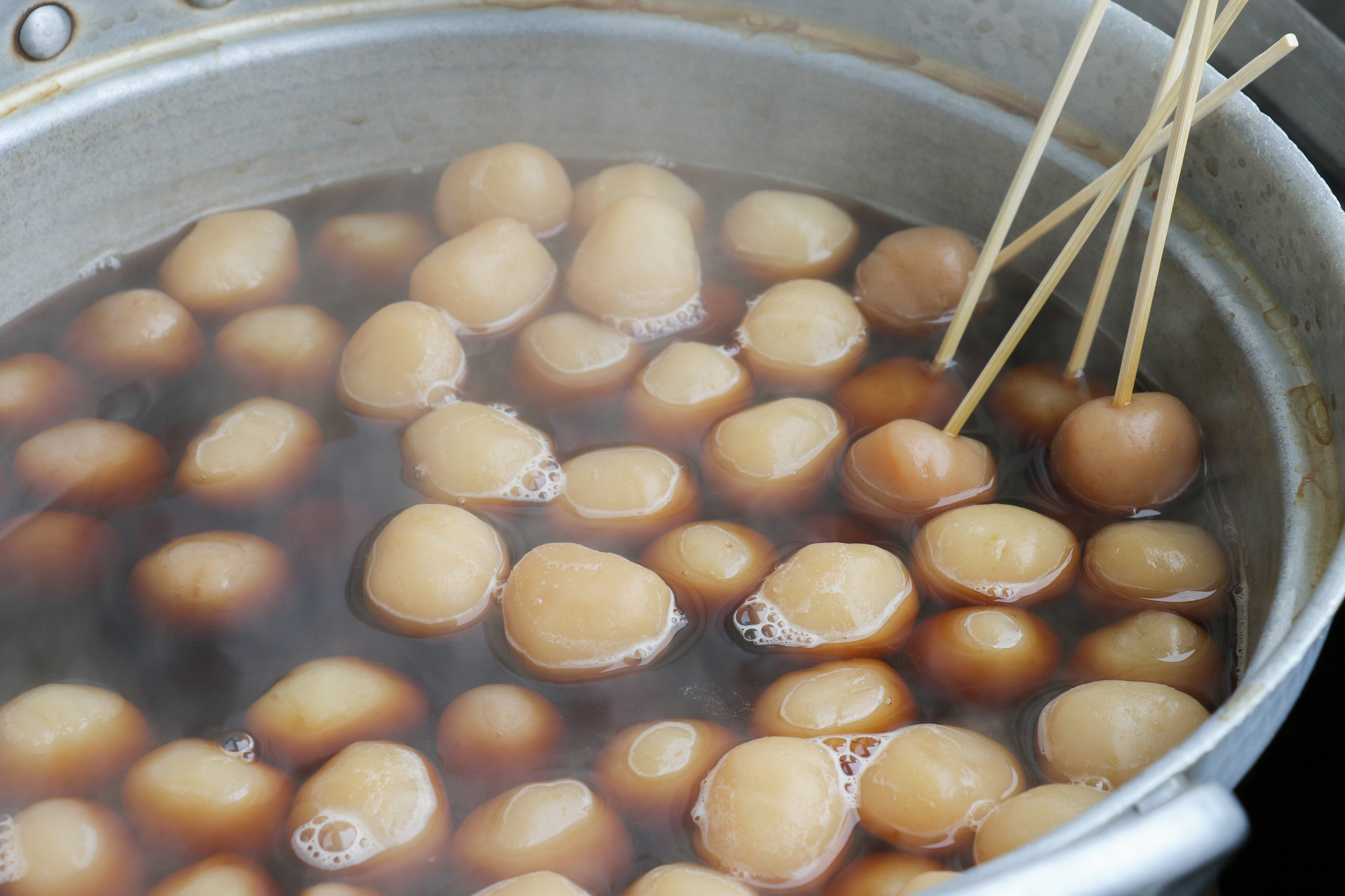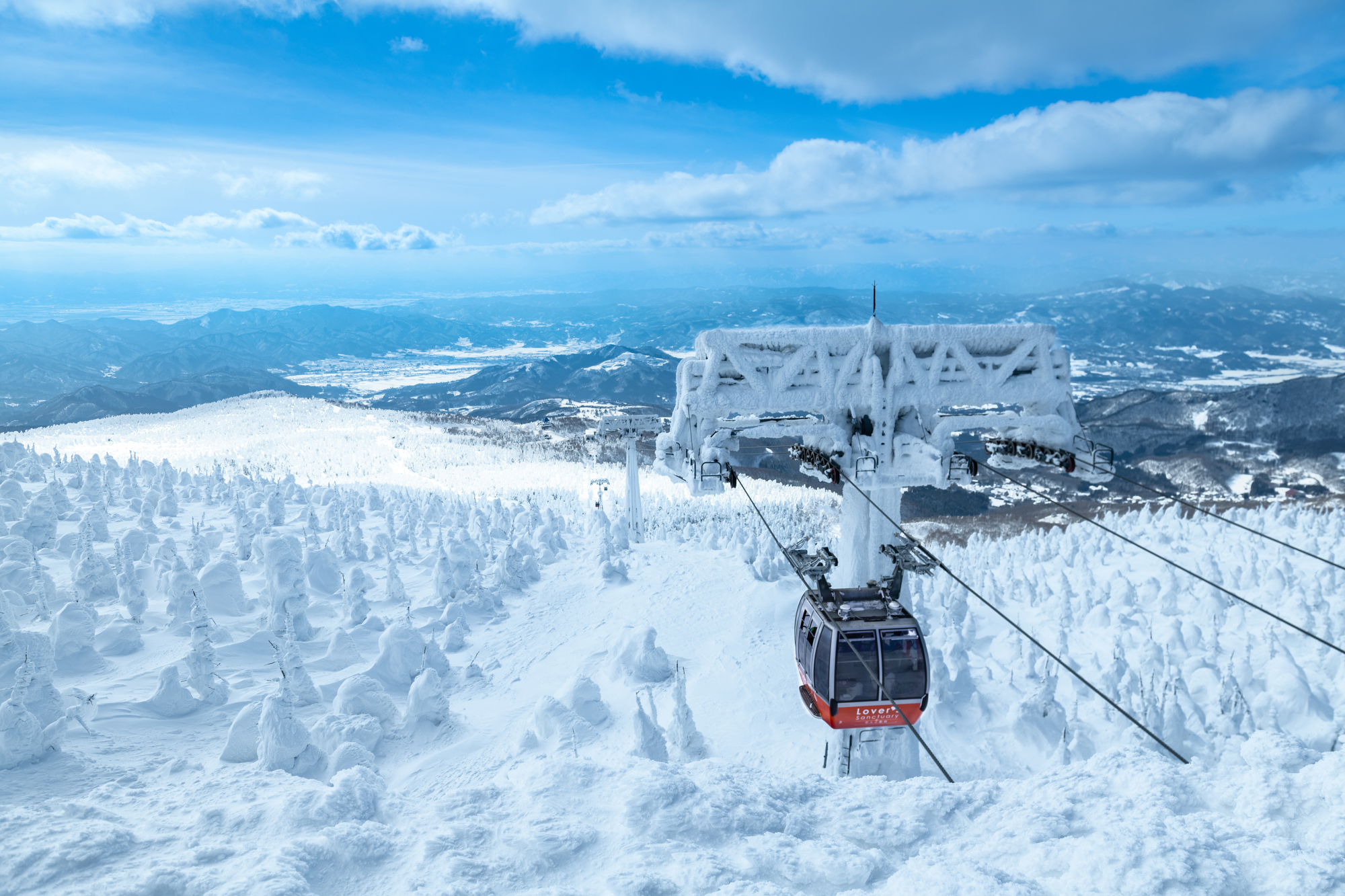Zao Onsen Complete Guide
Etiquette for Coexisting with the "Snow Monsters" of Ice and Snow
Table of Contents
An Encounter with the Art of Ice and Snow, the "Snow Monsters." Welcome to Zao.

In a world of silver, wrapped in silence, colossal masses of snow and ice rise towards the sky, writhing as if they were alive. Some resemble fierce giants, others a Madonna in prayer, with no two shapes alike. People call them with a sense of awe: "Snow Monsters."
Zao in Yamagata Prefecture is a miraculous place, one of the few in the world where you can see a colony of "Juhyo" (ice trees), a natural work of art. This spectacle, born from a perfect and coincidental combination of harsh winter weather conditions, captures the hearts of visitors with a beauty so overwhelming it can numb the senses.
But Zao's charm is not limited to its Juhyo. At its foot lies a highly acidic sulfur spring with a history of over 1900 years, renowned as the "Spring of Beauty" for its skin-healing properties. And its vast ski resort satisfies all skiers and snowboarders, from beginners to experts.
This guide is your invitation to experience this unique and spectacular scenery safely and respectfully. The Juhyo, while possessing an overwhelming power, are also extremely fragile and delicate. The manners introduced here are the wisdom and promises of us visitors to protect this ephemeral and beautiful natural art, to correctly enjoy the blessed hot springs, and to have fun in this severe natural environment.
Now, bundle up warmly and clear your mind. A dialogue with a sublime beauty that humans could never create awaits you.
1.Why Here? The Miraculous Story of How Juhyo and Highly Acidic Springs are Born
Why are Zao's signature "Juhyo" and "Onsen" concentrated in this particular place? The background is a grand drama woven by global weather patterns and volcanic activity since ancient times.
1-1. The Sculpture Created by Nature, "Juhyo": A Place Where Three Weather Conditions Meet
"Juhyo" (ice trees) cannot be seen just anywhere. They are born only when the following three miraculous conditions are met:
- Presence of Coniferous Trees: A colony of Aomori Todomatsu (Marumies' fir trees), a type of fir that easily accumulates snow and ice, serves as the core of the Juhyo.
- Strong, Unidirectional Seasonal Winds: A cold, moisture-laden wind blowing consistently from Siberia in a single direction.
- Supercooled Water Droplets and Snow: Mist-like water droplets that remain liquid below freezing, known as "supercooled water droplets," are carried by the wind. They violently collide with the branches and leaves of the fir trees and freeze. Snow fills the gaps, and layers of ice and snow build up, growing into a giant shape resembling a "shrimp's tail."
The summit area of the Zao mountain range, which meets all these conditions, is truly a miracle of nature, aptly called a "Juhyo factory."
1-2. A Famed Spring with 1900 Years of History: The Legend of Prince Yamato Takeru
The history of Zao Onsen is said to date back to around 110 AD. According to legend, the ancient hero Prince Yamato Takeru no Mikoto was wounded by an arrow during his eastern expedition, discovered the hot spring, and healed his wound here. During the Edo period, it prospered as a "toji-ba," a place for long-term hot spring therapy, attracting many people who crossed steep mountain passes in search of its healing effects.
1-3. The Secret of the "Spring of Beauty": The Science and Benefits of Highly Acidic Sulfur Springs
The most distinctive feature of Zao Onsen is its highly acidic sulfur spring, one of the most acidic in Japan. Its pH value is 1.2-1.6, a level of acidity comparable to lemon juice. This strong acidity is said to have a sterilizing effect on the skin and a peeling effect that removes old skin cells and promotes regeneration, earning it the names "Spring of Beauty" and "Spring of Rejuvenation." The sulfur component is also said to improve blood circulation and be effective for skin diseases and cuts. This unique water quality is a direct blessing of Mt. Zao's volcanic activity.
1-4. [2025 Update] Evolving Juhyo Viewing and a Sustainable Mountain Resort
![1-4. [2025 Update] Evolving Juhyo Viewing and a Sustainable Mountain Resort](/library/689c2e896e58203ab69c5bd3/68c275fc2d3eac3e9d197fe2.jpg)
The Juhyo fields, once a privilege for skiers, are now easily accessible to everyone thanks to ropeways and heated snowcats like the "Nightcruiser." The "Juhyo Light-Up" event, where the trees are illuminated with colorful lights in the dark of night, creates a fantastical world completely different from the daytime. On the other hand, in recent years, concerns have been raised about the withering of Aomori Todomatsu trees due to global warming. Initiatives for a sustainable mountain resort, such as tree-planting activities to protect the Juhyo, have begun.
2.Preparations & Basic Info: To the Mountain Where Snow Monsters Dwell
The Juhyo fields, over 1600 meters in altitude, are a completely different world from the ground below. Be fully prepared.
2-1. Complete Access Guide from Yamagata Station
- Local Bus (Recommended): From the bus terminal at the east exit of JR Yamagata Station, local buses to Zao Onsen run approximately every 40 minutes (journey time approx. 45 mins). No reservation is needed, and you can bring ski equipment.
- Taxi: Convenient for groups or when on a tight schedule.
- From Yamagata Airport: A reservation-based shared taxi, the "Yamagata Airport Liner," is available.
2-2. Understanding Zao's Geography: Onsen Town, Ropeways, and the Vast Ski Resort
Zao consists of the "Zao Onsen Town" at the foot of the mountain and the vast "Zao Onsen Ski Resort" accessible by ropeways and lifts.
- Access to the Juhyo Fields: From the onsen town, take the "Zao Ropeway" lines, transferring along the way, to the final stop "Jizo Sancho Station." The Juhyo fields spread out right before your eyes.
- The Ski Resort: It is extremely large with complex courses. First-time visitors should check the course map carefully beforehand and ski in areas appropriate for their level.
2-3. Dressing for Sudden Weather Changes: Knowing the Harshness of the Summit
The weather near the Zao summit is highly volatile. It's not uncommon for a clear day to suddenly turn into a blizzard, causing a "whiteout" phenomenon where visibility is almost zero.
- Clothing: Layering is key. Wear a base layer (quick-drying), a mid-layer (like fleece), and a ski wear top and bottom. Covering your face with a balaclava or neck warmer is also important.
- Equipment: Goggles with light-colored lenses suitable for blizzards and whiteouts are essential. It's wise to carry spare goggles and gloves, as well as emergency food, in your pocket.
3.[Crucial] To Coexist with Fragile Nature: 7 Manners to Keep in Zao
Sublime nature can sometimes be fragile and sometimes harsh. The utmost respect and caution are absolute prerequisites for enjoying Zao.
3-1. Juhyo are "Artworks Not to Be Touched": Show the Greatest Respect for Nature
You might be tempted to touch the giant snow monsters looming before you. However, Juhyo are extremely fragile structures of delicately balanced ice and snow. Never touch them or poke them with ski poles. Once they collapse, they will never return to their original form, making them a once-in-a-lifetime work of art. Cultural Context: Japan's "Mono no Aware" and the aesthetic of ephemeral things. In Japan, there is an aesthetic called "mono no aware," which finds deep beauty and emotion in transient things, like cherry blossoms. Juhyo, too, have a fleeting life of a single winter. Understanding their ephemerality and watching them quietly is the proper way to appreciate this beauty. |
3-2. At the Juhyo Light-Up: Appreciate the Drama of Light and Shadow in Silence
The illuminated Juhyo transform into a fantastical sculpture garden adorned with colors. Do not disturb this drama of light, performed in silence and darkness, with loud conversations. When using a tripod, please be considerate of other viewers and use it only in designated areas. Cultural Context: The beauty of "Yugen." The mystery that stands out in the dark. "Yugen," a concept in Japanese arts like Noh theater, refers to a profound and mysterious depth hidden behind things. The Juhyo light-up is a world of "yugen," where the contrast of light and shadow is enhanced by complete darkness, stimulating the viewer's imagination. |
3-3. As a Skier/Snowboarder: Safety on the Slopes is Your Own Responsibility
|
3-4. The Proper Way to Bathe in Highly Acidic Onsen: Maximizing the Water's Blessings
Because Zao's onsen is so potent, there are precautions to take when bathing.
|
3-5. Behavior in the Onsen Town: Respecting the History of a "Toji-ba"
Zao Onsen is a bustling resort, but it is also a traditional "toji-ba" (therapeutic spa). When walking through the town, refrain from being loud and be mindful that some people are there for medical treatment. Cultural Context: The culture of "Toji" and the appropriate quiet stay. "Toji" is a traditional Japanese spa therapy involving long stays at an onsen to heal illnesses and injuries. The underlying purpose is to rest the body and mind quietly. Respect for this history is expected. |
3-6. Coexistence with Wildlife: A Gentle Gaze for the Kamoshika
In Zao, you may encounter the Japanese serow (kamoshika), a national special natural monument. They are very timid animals. Do not shout or chase them; just watch them quietly from a distance. Cultural Context: Respect for Special Natural Monuments and Japan's approach to animal protection. Animals designated as Special Natural Monuments are legally protected as national treasures of Japan. Not threatening their habitat is considered a natural duty for Japanese people. |
3-7. On the Ropeway: The Gondola to the Summit is a Shared Space

The ropeway is very crowded during the Juhyo season. Be careful with large equipment like skis and snowboards so as not to disturb other passengers. Don't monopolize the best viewing spots; share them with others. Cultural Context: Mutual concession and spatial awareness in public transport. In limited public spaces, consideration for others is fundamental to smooth social interaction. The inside of a gondola is one such microcosm of Japanese society. |
4-1. Two Faces of Day and Night: The Juhyo Fields' Grand View and Fantastical Light-Up
4-2. Skiing the Vast Slopes: From the Famous "Zange-zaka" to Beginner Courses
4-3. Immersing in Onsen Culture: Public Bath Hopping and the Zao Grand Open-Air Bath
In the onsen town, there are three public baths (Kami-yu, Shimo-yu, and Kawahara-yu) also used by locals, where you can experience the essence of Zao's onsen. From spring to autumn, the "Zao Dai-Rotenburo" (Grand Open-Air Bath) is open, offering a dynamic bathing experience in nature (note that it is closed in winter).
4-4. Local Delicacies to Warm a Chilled Body: Jingisukan and Tama Konnyaku

The signature dish of Zao is "Jingisukan." It's a dish of grilled mutton with a special sauce that will warm you to the core. Also, the hot "Tama Konnyaku" (ball-shaped konjac jelly simmered in a soy-based broth) is an old-fashioned soul food that can be easily enjoyed during a stroll.
5.Planning Your Trip: Model Itineraries to Tour the Winter Wonderland
5-1. [Day Trip] Focusing on Juhyo Viewing! A Quick Trip from Yamagata Station
- Morning: Take a bus from Yamagata Station to Zao Onsen. Upon arrival, immediately head to the Zao Ropeway's summit station and explore the Juhyo fields.
- Noon: Have lunch at the summit station's restaurant with a view of the Juhyo.
- Afternoon: Descend by ropeway again. Experience the highly acidic onsen at a public bath in the town.
- Evening: Return to Yamagata Station by bus.
5-2. [1 Night, 2 Days] Skiing, Juhyo, and Onsen! The Ultimate Zao Winter Course
- Day 1:
〇Morning: Arrive at Zao Onsen. Leave your luggage at your inn and enjoy skiing/snowboarding.
〇Afternoon: Head to the summit via the Zao Ropeway. A special experience skiing through the Juhyo.
〇Evening: Check into your inn. Have the famous Jingisukan for dinner.
〇Night: View the illuminated Juhyo on the "Nightcruiser" snowcat tour. - Day 2:
〇Morning: Ski the first tracks on the morning slopes.
〇Noon: Lunch in the onsen town.
〇Afternoon: Stroll through the onsen town and look for souvenirs. Head back by bus.
The Awe of Nature to Take Home with You

When you finish your journey in Zao, the majestic figures of the snow monsters will be deeply engraved in your heart. However, an even more important memory might be the "awe of nature" you felt in front of this overwhelming natural spectacle, realizing the smallness of your own existence.
Quietly watching over the ephemeral artwork of the Juhyo, and soaking gratefully in the onsen blessed by the earth. The emotion gained through these humble acts is the greatest souvenir Zao can give us. That feeling will surely have a quiet, profound influence on your perspective on life.

